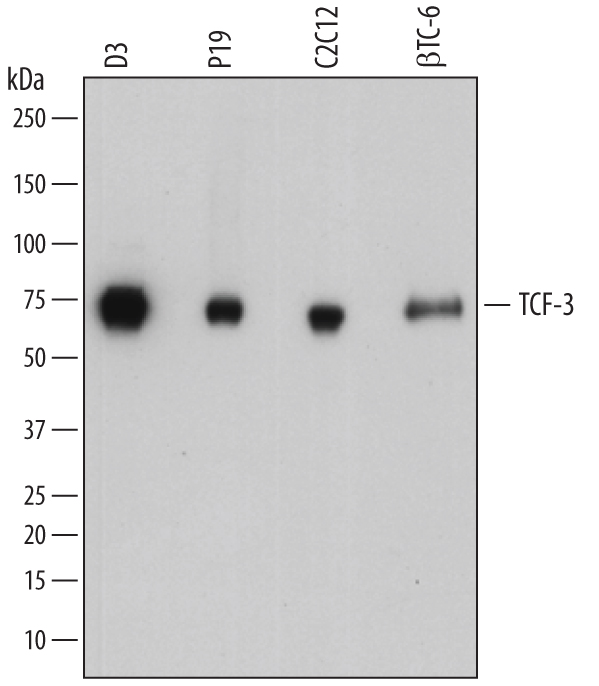Mouse TCF-3/E2A Antibody Summary
Specificity
Detects mouse TCF-3/E2A in direct ELISAs and Western blots.
Source
Polyclonal Sheep IgG
Purification
Antigen Affinity-purified
Immunogen
E. coli-derived recombinant mouse TCF-3/E2A
Asn33-Arg159
Accession # P15806
Formulation
Lyophilized from a 0.2 μm filtered solution in PBS with Trehalose. *Small pack size (SP) is supplied either lyophilized or as a 0.2 µm filtered solution in PBS.
Applications
Recommended Concentration
Sample
Western Blot
0.5 µg/mL
See below
Please Note: Optimal dilutions should be determined by each laboratory for each application.
General Protocols
are available in the Technical Information section on our website.
Scientific Data
Detection of Mouse TCF‑3/E2A by Western Blot.
Western blot shows lysates of D3 mouse embryonic stem cell line, P19 mouse embryonal carcinoma cell line, C2C12 mouse myoblast cell line, and beta TC-6 mouse beta cell insulinoma cell line. PVDF membrane was probed with 0.5 µg/mL of Sheep Anti-Mouse TCF-3/E2A Antigen Affinity-purified Polyclonal Antibody (Catalog # AF7650) followed by HRP-conjugated Anti-Sheep IgG Secondary Antibody (Catalog # HAF016). Specific bands were detected for TCF-3/E2A at approximately 70-75 kDa (as indicated). This experiment was conducted under reducing conditions and using Immunoblot Buffer Group 1.
Reconstitution Calculator
Reconstitution Calculator
Preparation and Storage
Reconstitution
Sterile PBS to a final concentration of 0.2 mg/mL.
Shipping
The product is shipped at ambient temperature. Upon receipt, store it immediately at the temperature recommended below. *Small pack size (SP) is shipped with polar packs. Upon receipt, store it immediately at -20 to -70 °C
Stability & Storage
Use a manual defrost freezer and avoid repeated freeze-thaw cycles. - 12 months from date of receipt, -20 to -70 °C as supplied.
- 1 month, 2 to 8 °C under sterile conditions after reconstitution.
- 6 months, -20 to -70 °C under sterile conditions after reconstitution.
Background: TCF-3/E2A
TCF-3 (Transcription factor 3; also Transcription factor A1 and E2A/alpha plus E12/E47) is a 68-75 kDa nuclear class I member of the bHLH family of molecules. It should not be confused with TCF-3, otherwise known as TCF7-L1, an epidermis-associated beta -catenin regulator. TCF-3 is ubiquitously expressed, and generally serves as a transcriptional regulator. It is able to form covalent homodimers, and following phosphorylation, heterodimers with tissue-specific class II bHLH factors, thus impacting the proliferation and differentiation of select cell types. While heterodimers, and possibly homodimers, activate genes by binding to E boxes, heterodimers involving Id proteins are gene repressors. Mouse TCF-3/E12 is 651 amino acids (aa) in length. It contains one Leu-zipper motif (aa 387-422) plus a bHLH domain (aa 544‑604). TCF-3 contains at least three potential Ser phosphorylation sites. There is one alternative splice form that is termed E47 and shows a 69 aa substitution for aa 527-598. This involves the bHLH domain, and it is believed that each splice form has a distinct function(s). Both splice forms (E12 and E47) do occur simultaneously in the same cell type. Over aa 33-159, mouse TCF-3 shares 94% and 75% aa sequence identity with rat and human TCF-3, respectively.
Long Name
Transcription Factor 3/E2-alpha
Entrez Gene IDs
6929 (Human); 21423 (Mouse); 312451 (Rat)
Alternate Names
bHLHb21; bHLHb21TCF-3; Class B basic helix-loop-helix protein 21; E2A immunoglobulin enhancer-binding factor E12/E47; E2A; E2AKappa-E2-binding factor; Immunoglobulin enhancer-binding factor E12/E47; Immunoglobulin transcription factor 1; ITF1; ITF1Transcription factor ITF-1; Kappa-E2-binding factor; MGC129647; MGC129648; Pan2; TCF-3; Tcfe2a; transcription factor 3 (E2A immunoglobulin enhancer binding factors E12/E47); Transcription factor 3; transcription factor E2-alpha; VDIR; VDR interacting repressor
Product Datasheets
You must select a language.
x
 View Larger
View Larger


